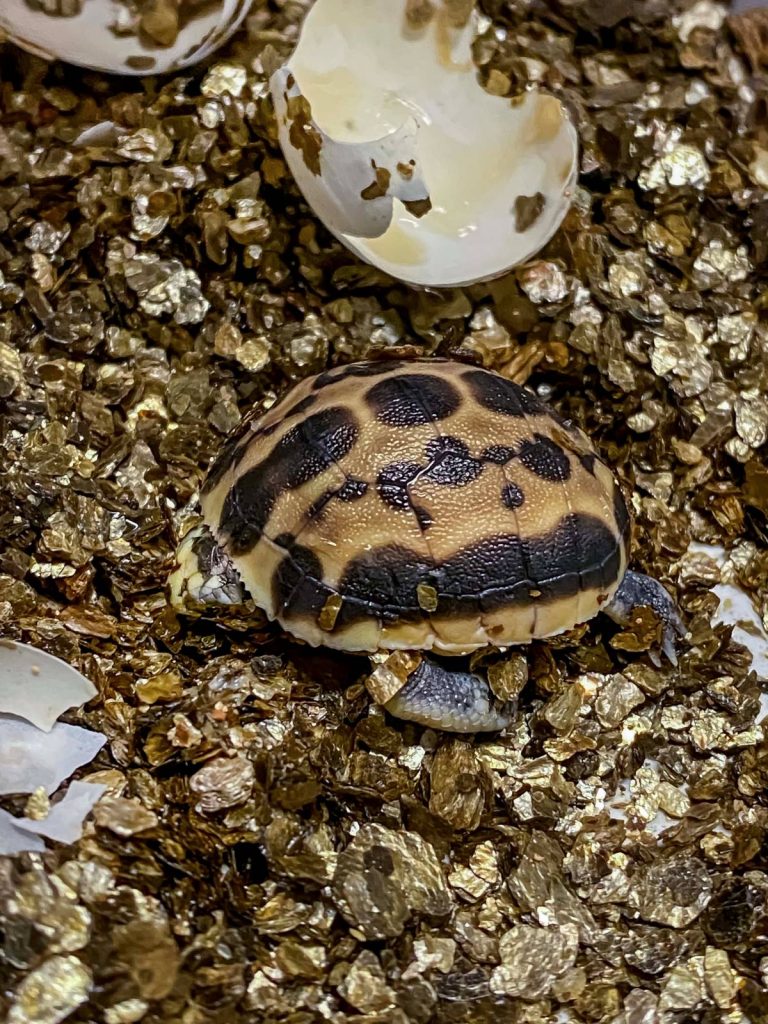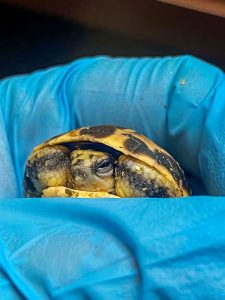
The Milwaukee County Zoo is excited to announce the first-ever hatching of a northern spider tortoise. The egg pipped (cracked open) April 10, and the tortoise emerged from the egg April 12. The female laid the egg August 30, 2022, and it was incubating for more than 200 days! This particular hatchling is significant in that northern spider tortoises are listed as critically endangered in the wild, according to the International Union for the Conservation of Nature (IUCN).
The egg hatched to the Zoo’s pair; a 21-year-old male, and 12-year-old female. The parents were not involved in the hatching, rather zookeepers gave the egg the proper environment to incubate. The hatchling now lives in a separate habitat from its parents. 
The hatching is considered exceptional because the egg(s) laid by the female must go through a heating and cooling process, otherwise they will fail to hatch. Sometimes the eggs are just infertile or may fail to hatch even if they are heated and cooled correctly.
Interestingly, the Aquatic and Reptile care team used a wine chiller for incubation – first heating the egg to 84 degrees Fahrenheit for six weeks, then slowly dropping the temperature two degrees each day until it reached 55 degrees. The egg was kept at the 55-degree temperature for 8 weeks, after which it was increased two degrees each day until it reached 86 degrees. The egg remained at 86 degrees until hatching. In the wild, the egg would experience the same temperature changes which is likely why it was a successful method of incubation in a Zoo environment.
Because this was such an unusual and delicate hatching situation, zookeepers collaborated with the reptile care team at the Smithsonian’s National Zoo, as they had successfully hatched this species in the past. The Smithsonian’s team suggested using a wine chiller to regulate the temperature of the egg.
 The spider tortoise’s shell can grow up to about 7 inches and is the smallest of the four endemic tortoise species of southwestern Madagascar (its natural habitat). Females average just less than 5 inches in length and are usually slightly larger than males, which average 4.5 inches. The future of this tiny tortoise is jeopardized by habitat destruction and overcollection for the pet trade.
The spider tortoise’s shell can grow up to about 7 inches and is the smallest of the four endemic tortoise species of southwestern Madagascar (its natural habitat). Females average just less than 5 inches in length and are usually slightly larger than males, which average 4.5 inches. The future of this tiny tortoise is jeopardized by habitat destruction and overcollection for the pet trade.
In the wild, during the hot, dry season, spider tortoises go through a period of dormancy similar to hibernation. The species is named for the intricate yellow, web-like pattern of its shell. The life expectancy of this species is approximately 70 years.
The Zoo’s hatchling will remain behind the scenes, not in public view until it’s large enough to be housed with the adults — about 1-3 years. Zookeepers report the hatchling is eating very well, which “is always exciting!”
© 2025 Milwaukee County Zoo. All Rights Reserved | Privacy Policy